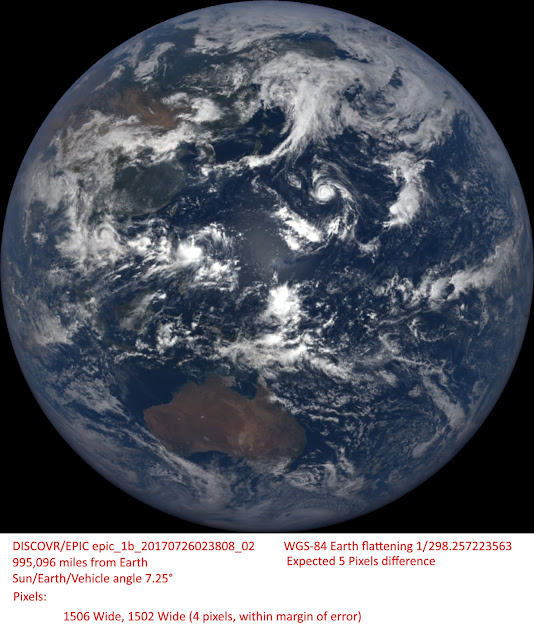Do "NASA" full frame images of the Earth show a perfect circle or an ellipsoid?
To answer this I grabbed one of the DISCOVR/EPIC frames epic_1b_20170726023808_02 and I found that the Earth was approximately 1506 pixels wide -- this is the semi-major (a) axis:
Next, we need to calculate how tall we would expect the Earth Ellipsoid to be IF it wasn't a perfect circle. To do this we get the model value from what is called WGS-84 (World Geodetic System from 1984), which is the current measured values for Earth. It defines the measured semi-major axis (a) and something called 'flattening', using this you can calculate the semi-minor axis (b) using a simple equation that defines this relationship for an ellipse:
ƒ = (a − b)/a
Therefore, b = a - aƒ
From WGS-84 we have:
1/ƒ = 298.257223563
Therefore, ƒ = 1/298.257223563
So given our semi-major axis (a) is 1506 pixels wide we would expect our semi-minor axis (b) to be approximately:
b = 1506 - (1506 × (1/298.257223563)) ~ 1501 pixels
And that is what we find, to within 1 pixel, in the image from DISCOVR. Since the edges are fuzzy and the atmosphere isn't helping so we are within our margin of error. But this also clearly is not a perfect sphere, we're 4 pixels from it being a perfect sphere.
We can also estimate that since the Earth equatorial radius is 6378137.0 meters radius that we're seeing about (6378137.0*2)/1506 = 8470.3 meters PER pixel here (or 5 1/4 miles per pixel).
So this image comports extremely well with what we expect from an ellipsoidal Earth.
Next, we need to calculate how tall we would expect the Earth Ellipsoid to be IF it wasn't a perfect circle. To do this we get the model value from what is called WGS-84 (World Geodetic System from 1984), which is the current measured values for Earth. It defines the measured semi-major axis (a) and something called 'flattening', using this you can calculate the semi-minor axis (b) using a simple equation that defines this relationship for an ellipse:
ƒ = (a − b)/a
Therefore, b = a - aƒ
From WGS-84 we have:
1/ƒ = 298.257223563
Therefore, ƒ = 1/298.257223563
So given our semi-major axis (a) is 1506 pixels wide we would expect our semi-minor axis (b) to be approximately:
b = 1506 - (1506 × (1/298.257223563)) ~ 1501 pixels
And that is what we find, to within 1 pixel, in the image from DISCOVR. Since the edges are fuzzy and the atmosphere isn't helping so we are within our margin of error. But this also clearly is not a perfect sphere, we're 4 pixels from it being a perfect sphere.
We can also estimate that since the Earth equatorial radius is 6378137.0 meters radius that we're seeing about (6378137.0*2)/1506 = 8470.3 meters PER pixel here (or 5 1/4 miles per pixel).
So this image comports extremely well with what we expect from an ellipsoidal Earth.



Comments
Post a Comment